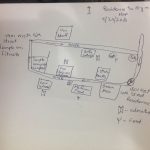Evaluating BMI, BC, and Fat Distribution
Evaluating BMI, BC, and Fat Distribution
Weight measures are used in health settings to guide decisions regarding treatment plans. Body fat could be one of the cause of weightiness in a human. Fat in a human body may not be evenly distributed. People may have excess of fat at some parts of their body that is visible in different shapers. For example, people with more fat around the middle parts of their body, especially their stomach have an apple shaped body. Others may have more fat concentrated around their hips or buttocks which gives them a pear shape.
Research has indicated that people with more fat concentrated at the areas near to their stomach, apple shaped, are more prone to obesity (Health, 2016). Fat Distribution is used to evaluate human health. Body Mass Index (BMI) and BC are also measures used to evaluate human health. Body Mass Index or BMI is a measure of human fitness according to height and weight of an individual. Body Composition or BC provides a better evaluation of the fat in the body.
It is a better evaluation of fitness as it breaks down the fat and fat free mass of a human body. In the following discussion, I have provided a detailed overview of Fat Distribution BMI and BC. An overview of how they are measured and evaluated is also provided.
Fat Distribution
Fat distribution is a useful measure when a person may be classified as normal weighted but there is fat accumulation in the abdominal areas (Koda-Kimble, 2012). There are many ways to measure body fat distribution. For example, Skin Calipers is used by clinicians in which a device called skin caliper device. The clinician would pinch the skin at three to seven skin sites of a human body and the device is then used to measure the thickness of the skin fold.
BMI (Body Mass Index)
BMI is a measure of categorizing an individual to underweight, normal, overweight or obese. BMI is achieved by dividing the mass of the body by the square of the height. Different measures of BMI signify different fitness levels. For example normal weight BMI is 18.5 to 25, 25 to 30 is overweight while over 30 is classified as obese.
BC (Body Composition)
Body composition is a much more detailed measure of human fitness. It provides information about fat, bone, water and muscle percentage in a human body. One of the methods used to measure BC is called bioelectrical impedance in which a little electric impulse is sent over different parts of body and the time it travels back is measured. The current has different travel time through fatty and lean tissues which is the primary mechanism the device utilized to measure fat in different part of the body.
The above measures can be used to know the fat percentage of the body and make necessary changes to the daily diets and physical activities so that healthy life choices can be made. BMI is an easy to conduct measure as it can be simply calculated with a person’s weight and height. On the other hand BC is a much more detailed measure of the body fat and should be conducted in the supervision of a professional healthcare worker so that the process of body fat distribution measurement and the inferences drawn on the basis of this measurement are correct. These measures should not be made very often like on weekly basis when a person is trying to bring about a change in the body fat distribution, as these changes may not take place soon after an activity is started to do so, instead it should be done once in six month (DuVall, & DuVall, 2017).




